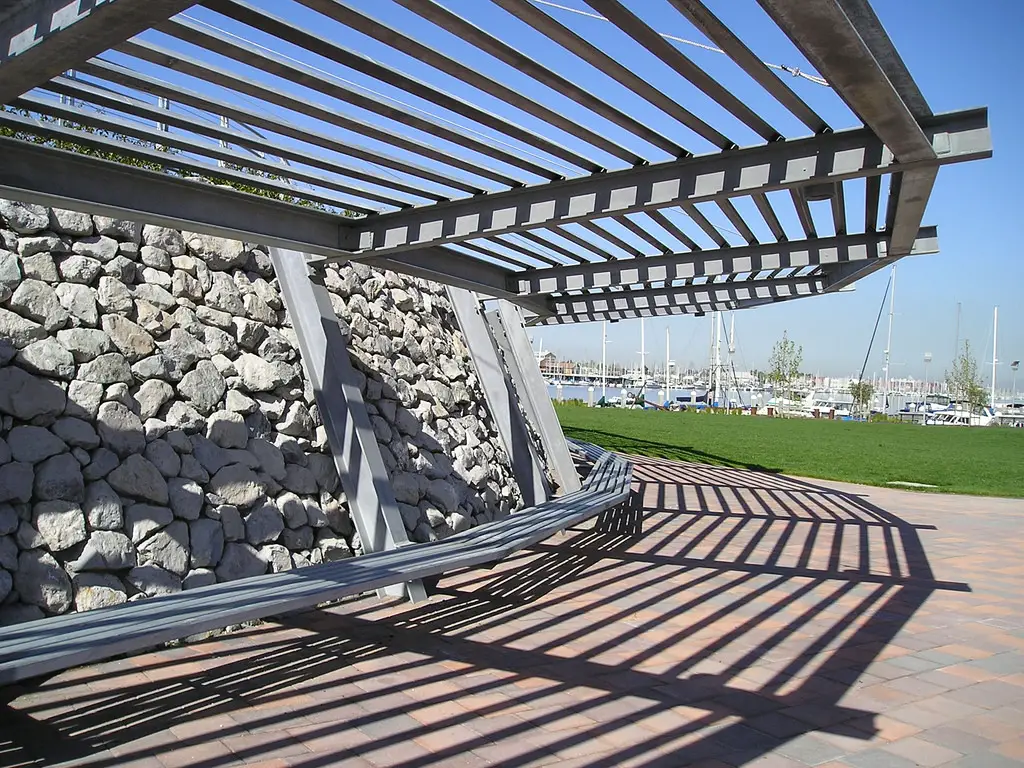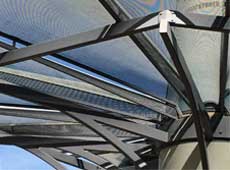Last Updated:July 23, 2025
How do retractable awnings work?

Retractable awnings are very popular for homes due to their versatility. They can be extended during the summer to provide shade for a back patio or deck, and they can be retracted during heavy snowstorms, periods of heavy wind. Additionally, companies even offer awning covers that will protect both the fabric and frame during the winter without the need to remove them from the side of the home.
In this article, we’ll go into great detail of the inner workings of retractable awnings. I researched this post by speaking to representatives from 5 different awning installation companies in my home state.
My goal is to provide a complete and exhaustive deep dive, and I didn’t want the information to be solely limited to one manufacturer. We are an independent company that doesn’t directly sell or install awnings. We research the best products and companies to share the information on a level playing field.
What are the parts of a retractable awning
In this section, we’re going to elaborate on the 8 primary components of a retractable awning. This covers the most common options available on residential awnings. If you are considering something that’s not on our list, feel free to send us a message on our contact form, and we’ll provide our opinion on the topic and hopefully be able to point you in the right direction.

Top picks for retractable awning fabric
By area, the fabric is by far the largest component. The material will either be solution-dyed acrylic or polyester/vinyl. There are some very old canopies that were constructed with a coated canvas; however, those haven’t been commonplace for more than 30 years.
Polyester and vinyl are the budget-friendly options. These are suitable for entry-level shelters. This material can last 5-10 years with yearly maintenance. The major drawbacks to this are that it is prone to fading and discoloration. It can also have tears or rips if it left out during heavy storms. When comparing two fabrics of this type look at the weight. This is measured in grams per square meeting which is normally written 280 g/m2. We really prefer 280 grams, and we would never purchase anything less than 220 g/m2.
Solution-dyed acrylic is the higher end option. This fabric is created from individual extruded acrylic fibers are woven into a large cloth. Because the color goes throughout the entire strand, these are incredibly resistant to any fading or discoloration. The weight isn’t as crucial to verify for this material. There just isn’t a demand for people who are willing to spend on the higher quality fabric, but want to cheap out on its thread count.
This type of fabric can last decades with proper yearly maintenance. Many of the manufacturers and sellers will include a 10+ year warranty on the product. This is less of a deciding factor than warranties on other components. Normally, we expect the drive train or arms to have issues long before anything occurs with an acrylic fabric.
What are retractable awning cassettes?
The cassette is the metal case that houses the awning fabric when it is wound up. All the cassettes we looked at were constructed of aluminum. This seems to be the most common metal, and I didn’t hear of any company that was using steel.
One discovery is that some of the lowest end models didn’t have a cassette housing whatsoever. The rolled up fabric is left exposed to all the elements. Normally, we are not fans of this design style because of the increased wear on the internal gears. If you do have this style, we highly recommend getting an awning cover. This will create some barrier to protect it from the harsh weather. Here’s a link to our favorite awning cover.
What are the types of support arms?
For completeness, we’ll review both types of awning arms. The two types are telescoping hydraulic arms and folding mechanical arms. I am only including the hydraulic option for the sake of completeness.
We highly recommend never purchasing the telescoping hydraulic or gas driven arms. From our experience, these don’t have the same lifespan as the folding arms. They can also require maintenance to fix any leaks in the fluid.
The vast majority of retractable awnings you’ll consider will be the folding support arms made of aluminum. Small and medium awnings will have two awnings with one on each side near the edge of the fabric.
Awnings over 8′ wide will often have additional support arms placed in the middle. I’ve seen models with 3 and 4 support arms. I was told anything over 4 support arms is best divided into two separate awnings, and one installer suggested always staying below 8′ maximum. He said is nearly every case, he’d rather have 2 smaller awnings than one single super-wide shelter.
What is a header bar?

The header bar is the long metal rod that sits at the front of the awning. These will be present for all fixed frame awnings; however, it is optional for retractable awnings.
The advantage of the header bar is that it makes the entire canopy more wind resistant and overall sturdy. If you’re only going to use the awning on sunny days and keep it retracted before any snow or storms, there’s no need to have this bar.
What is the drivetrain in a retractable awning?
There are three choices for the internal drive train of the awning. The first is a chain which is similar to a bicycle chain. These are mainly seen on older awnings or extremely cheaply constructed awnings, and we would never recommend purchasing an awning that uses an open gear chain.
The second drive train is a steel cable. The cable is normally coated with a plastic to reduce friction and extend the lifespan of the inner workings. Many companies even offer a double cabling which is where two cords are used to control the arm. This creates more stability by evening out the workload. Always verify the internal steel cable is coated to limit any rusting and weather damage.
The final option is only seen on a few extremely high-end awning models. Instead of a steel cable, it uses a woven flat belt. It resembles a seatbelt from a car. The only difference is that it is less wide and constructed from a woven kevlar material. The belts age the best and create minimal wear and tear on the gears. Drivetrains made from woven belt can often last decades.
What is the drivetrain in a retractable awning?
There are three choices for the internal drive train of the awning. The first is a chain which is similar to a bicycle chain. These are mainly seen on older awnings or extremely cheaply constructed awnings, and we would never recommend purchasing an awning that uses an open gear chain.
The second drive train is a steel cable. The cable is normally coated with a plastic to reduce friction and extend the lifespan of the inner workings. Many companies even offer a double cabling which is where two cords are used to control the arm. This creates more stability by evening out the workload. Always verify the internal steel cable is coated to limit any rusting and weather damage.
The final option is only seen on a few extremely high-end awning models. Instead of a steel cable, it uses a woven flat belt. It resembles a seatbelt from a car. The only difference is that it is less wide and constructed from a woven kevlar material. The belts age the best and create minimal wear and tear on the gears. Drivetrains made from woven belt can often last decades.
What are mounting brackets made of?
When it comes to awning mounting brackets, we want steel. They can either be stainless steel or galvanized. I prefer to avoid any awning that is packaged with aluminum brackets. If a company cheaps out on the bracket, it leaves me concerned what type of components on the inside that I can’t check.
If you’re not sure how to check the type of metal, you can either use a magnet or a file. The magnet will be attracted to steel brackets, and there will be no pull to aluminum. If you don’t have a magnet, you can use a file against the exposed backside of the bracket. Since it goes against the house, and slight scratches won’t be seen, and only steel will produce sparks when it is rubbed against the file.
Brackets are one of the areas that we strongly suggest not using a DIY solution. If the mounting hardware fails, it could lead to people getting hurt or serious property damage. If you’re going with a DIY awning OR you need to replace some damaged hardware, the best suggestion is to seek an expert at your local home depot. They normally have a help desk near the center of the store that will help customers decide what products to buy. Their advice will be far superior to any generic suggestions I could share in this post.
What is a retractable awning handle/crank?

The handle is a metal rod that is normally 24″ to 36″. One end will have a handle that is slightly offset allowing it to be turned easily. The other end will have a hook that fits into a clip next to one of the brackets. The awning is extended or retracted by rotating this clip.
The awning handle is designed this way so that it can easily be removed from the frame and kept inside. We normally only have the handle outside if we are opening or closing the awning.
This is such a universal design that there are many companies that sell replacement awning handles. Here’s a link to our favorite replacement awning handle. This isn’t an item that I’d suggest splurging. There are even some really good DIY options for awning cranks/handles that can be constructed for less than $5.
Wrapping up
Thanks for reading our super long post on retractable awnings and how they work. I plan for this article to grow over the years, and a great way to find the gaps is listening to our readers.
If you have ideas or questions, feel free to use our contact form or send us a tweet @newawning . We love hearing from our site’s visitors. Just as reminder for first time readers, we are regular home owners who became interested in awnings and shades several years back. No member of the writing team is a licensed contractor or carpenter. If you have specific questions or need professional recommendations, we’re unfortunately not the right resource for that.




